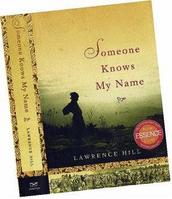A look at life as a slave
Published: Sunday | January 11, 2009

Title: Someone Knows My Name
Author: Lawrence Hill
Reviewer: Barbara Nelson
"I am Aminata Diallo, daughter of Mamadu Diallo and Sira Kulibali, born in the village of Bayo, three moons by foot from the Grain Coast in West Africa. I am a Bamana. And a Fula. I am both ... ."
It's around this imaginary 18th-century African woman with "rich, dark skin" and "lovely crescent moons sculpted into her cheekbones" which show she was a freeborn Muslim that author Lawrence Hill weaves a wonderful, poignant, fictional story. Aminata had another scar, just above her right breast, where she was branded with a hot iron after she was kidnapped. She was 11 years old.
The story explodes with the capture of Aminata and others in her village, the murder of her parents and the various unimaginable horrors that accompanied the slave trade. On the long, forced walk from her village to the "big water", she met "the boy who worked for our captors" and who came back many times to offer her water and food. The boy, Chekura, who was "as thin as a blade of grass and as ungainly as a goat on three legs" would eventually play a major role in her life.
The author of the exquisitely written story, Lawrence Hill, lives in Ontario, Canada, and is the son of civil-rights activist Donna Hill and Daniel G. Hill, a sociologist who descended from Africans enslaved in the United States. Hill was influenced by the work that his parents did in Canada's human-rights movement and in writing about the history of blacks in Canada.
'fattened up'
Hill takes the reader into the bowels of the journey from the notorious Bance Island across the Atlantic Ocean, where men and women were stacked into the stinking holds of ships. Many became ill and some died on the journey. Their bodies were simply thrown overboard "without ceremony". By the end of the voyage, about one-third of the captives had perished.
Aminata and the other survivors are taken to South Carolina where they are "fattened up" and their skin oiled prior to being sold into slavery, years of slavery during which time she learned to make indigo, to read and write, helped to "catch babies" (a skill she had learned from her mother) and suffered the indignity of being raped by her white master, the wicked and caitiff Robinson Appleby.
But even in the years of emotional distress and pain that followed, there was light in her life, Aminata found love and gave birth to a son, a beautiful child who was taken from her when he was 10 months old and sold into slavery. Shattered by the loss of her child, she refused to work and stopped eating. Soon she, too, "a Guinea wench", was sold in 1762 for 60 pounds sterling to Solomon Lindo, a Jew from Charleston.
That change in her life once again rips the thin fabric of friendship and family in Aminata's life. Events over which she has no control swirl around her and in the chaos of the Revolutionary War, she finds a way to escape.
She finds herself in Manhattan where she helps to write the Book of Negroes, a list of black people who were rewarded for their service to the King of England. Finally, in 1783, she was allowed to leave "the 13 Colonies ... that would be called the United States". She was on her way to Nova Scotia.
Once again Aminata struggles through great difficulties, including freezing cold weather. Somehow she survives. "Many times that winter," she says, "I slid on to my knees and called out the names of my parents, my son and my husband, crying for them as if they had just gone missing with my most recent exhalation."
She gives birth to her daughter, May, then finds work with the Witherspoons, working from dawn to dusk cleaning their large house, hauling water and wood, cooking, buying food and running other errands for a shilling a day.
daughter stolen
But Aminata's life is thrown into turmoil again as her baby daughter is stolen from her. Her ability to read and write serve her well, however, as she links up with John Clarkson, a lieutenant with the British Navy, who is working to offer "loyal Negroes passage to a new life in Africa".
After living in Nova Scotia for 10 years, Aminata eventually becomes one of the 1,200 people who leave voluntarily for Sierra Leone on 15 ships to set up a colony.
"It had seemed too much to hope for," but here she was 36 years later back in her homeland, 18 miles away from the very place where she had been placed on the slave ship.
But there was still another chapter to be written in Aminata's life and it was to take place not in her homeland, but in England.
